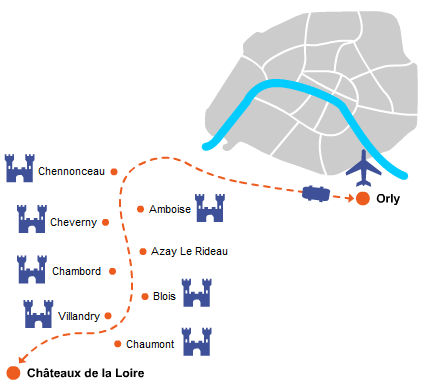Choose your route
Transfer Orly - Castle in the Loire Valley

Orly Airport - Castle in the Loire Valley
Private car and van transfer to/from Orly Airport to Castle in the Loire Valley
| Passengers | 1 - 2 | 4 - 5 | 6 - 7 | Action |
|---|---|---|---|---|
| Orly Airport - Castle in the Loire Valley | €450 | €480 | €630 | Book now |
| CDG Airport - Tours | €540 | €570 | €690 | Book now |
| Angers - CDG Airport | €640 | €820 | €860 | Book now |
Travel from Orly Airport to the magnificent castles of the Loire Valley with our private car service. Our professional chauffeur ensures a smooth, elegant journey, making your visit unforgettable. Explore stunning sites like Château de Chambord with its famous Renaissance architecture, and Château de Chenonceau that stretches gracefully over the Cher River. The region's beauty, history, and comfort are within easy reach. For your comfort and safety details, please visit frequent airport questions answered. Our reliable service guarantees punctuality, comfort, and convenience, perfect for families or business travelers seeking to experience French heritage in style.
Beyond the Loire Valley, enjoy exceptional transfers from CDG Airport to Tours, a charming city with the impressive Saint-Gatien Cathedral and lively Place Plumereau, or travel easily from Angers to CDG Airport. Angers is home to the majestic Château d'Angers and the medieval Apocalypse Tapestry. Our experienced drivers ensure a seamless experience tailored to your needs. For more options and destinations, discover our complete airport rates guide. Travel stress-free and enjoy the best of France’s historic treasures.
Book a private shuttle transportation between Orly airport and the castles of the Loire Valley


















